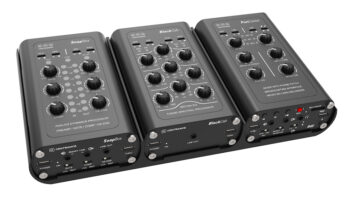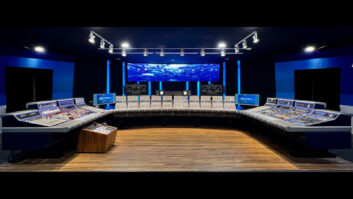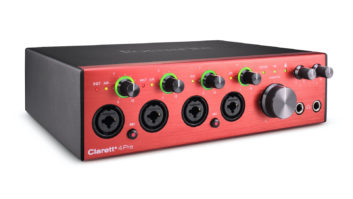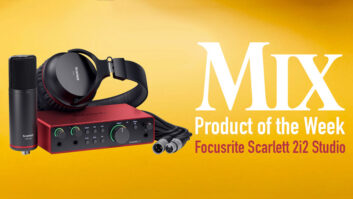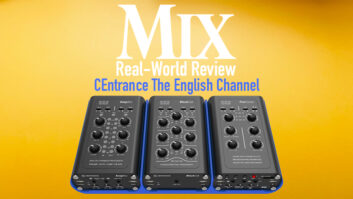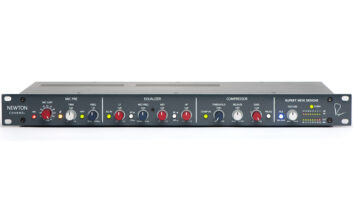
If imitation is the most sincere form of flattery, then the new 2U, split-personality processor from Focusrite is a downright apple polisher. The Liquid Channel emulates the sonic characteristics of dozens of modern and vintage mic preamps and compressors, combining one preamp and one compressor replica of your choice across the signal path. To accomplish its mimicry, the unit uses dynamic convolution, a DSP process in which the captured impulse responses of the original units are applied mathematically in real time and on a level-dependent basis to The Liquid Channel’s audio input signal at single sample intervals. Worst-case latency for throughput is better than 2 ms.
To account for impedance loading and differing input topologies in various mic and preamp combinations, The Liquid Channel also switches capacitors and resistors and alternates between transformer- and electronically balanced input stages as needed to emulate a specific preamp. When you recall a specific mic preamp replica in The Liquid Channel, the analog circuit path changes at the same time that the convolved replica of the pre is being loaded in the digital domain. All compressor replicas, on the other hand, exist solely as convolution data in the digital domain. The unit also includes a modeled (not convolved) 3-band digital equalizer loosely based on the company’s ISA 110.
SIGNAL FLOW
The Liquid Channel offers mic, line and AES/EBU inputs on rear panel XLR connectors selected in turn from the unit’s front panel. Mic input signals go through the analog mic pre stage, A/D (an AKM 5394 chip), digital preamp convolution section, and compressor and EQ sections (in that order, unless the EQ is placed pre-compressor by a front panel switch), and exits the unit via AES/EBU or analog line-level XLR output. Analog line input signals go straight to the A/D and bypass all mic preamp circuitry (including, unfortunately, digital replicas), but otherwise follow the same path as mic input signals. Digital input signals that access a transformer-balanced preamp replica are first routed out the unit’s D/A and then follow the same signal path as mic input signals (from analog mic pre stage and A/D through to output). Digital input signals that access an electronically balanced preamp replica go straight to the digital preamp convolution section, then follow the same signal path as analog line input signals.
The Liquid Channel processes audio at 24-bit depth and at any standard sampling rate from 44.1 to 192 kHz. A-weighted dynamic range specifications for the A/D and D/A are 120 and 116 dB, respectively, and maximum I/O levels are +22 dBu. The unit can lock to internal crystal, AES/EBU input or word clock—the latter via a rear panel BNC input connector. Multiple units can be linked for stereo or surround operation using rear panel RCA connectors.
UP FRONT
The Liquid Channel’s front panel controls are beautifully laid out and intuitive. All dials are rotary encoders that—with the exception of a data wheel that scrolls through and selects preamp and compressor replicas—are surrounded by LED rings indicating their approximate level settings. An LCD shows more exact numerical parameter readouts, replica names and operational prompts in two rows of characters.
A gain dial adjusts gain for mic input signals from +6 to +80 dB or for line or digital inputs from -10 dB to +10 dB (in 1dB steps). The gain is digitally controlled, except in the analog domain for mic and line input signals and in the digital domain for digital input signals. A nicely resolved LED bargraph meter shows input level (mic, line or digital) post-A/D from -20 to 0 dBFS, but it lacks peak-hold functionality. Strangely, I found that the accompanying digital clip LED sometimes lit at levels as low as -8 dBFS on percussive sources and didn’t work at all on digital input signals.
Mic inputs have access to defeatable +48-volt phantom power. Mic, line and digital inputs all have access to polarity inversion, a highpass filter (the latter switchable between 75 and 120Hz corner frequencies with a 12dB per octave slope) and a special Session Saver function. Session Saver automatically turns down the input gain (without using compression) in 1dB steps to a maximum cut of -3 dB when the input signal starts to clip.
If you don’t want to use a preamp replica, The Liquid Channel lets you select a flat, electronically balanced input. Conversely, a Harmonics dial incrementally adds second, third and fifth-order harmonics in amounts that are dependent on both input level and the specific mic preamp replica selected. Because no two vintage units sound exactly alike, the Harmonics dial lets you further tailor a replica’s sound to approximate (or intentionally depart from) a particular hardware unit’s sound. I found that Harmonics added beautiful, analog-sounding coloration in easily managed amounts ranging from subtle to extreme.
The Liquid Channel has two parameter modes to tweak its compressor replicas: One limits parameter ranges to those found on original hardware units (although I found this to not always be the case) and the other provides more freely assignable values. In the latter mode, you can adjust threshold range from -40 dB to +20 dB in 1dB steps, ratio from 1:1 to limiting, attack and release times each from 0.1 ms to 2.5 seconds, and makeup gain from -20 dB to +20 dB in 0.5dB steps. An LED bargraph meter shows gain reduction from -0.1 to -15 dB. The compressor can be independently bypassed.
The Liquid Channel’s 3-band EQ provides high- and low-shelving bands and a parametric midrange band. The low-shelf’s range covers 10 to 1k Hz, mids go from 100 to 10k Hz and highs can be shelved anywhere between 200 and 20k Hz. All bands provide ±18dB gain. The middle band’s Q is adjustable from 0.8 to 2.5. Although the EQ can be globally bypassed, independent bypasses for each band are not provided. The EQ can be routed to the compressor section’s sidechain, and a Sidechain Listen function is provided. The Liquid Channel’s EQ sounded wonderfully smooth, full-bodied and responsive.
GET WITH THE PROGRAM
Users can name, save, recall and edit The Liquid Channel’s current “program,” which comprises all front panel controls. One hundred program memory slots are on board, and the unit ships with 40 replicas each of preamps and compressors. (A complete list can be found at focusrite.com/products/liquid/liquid_channel/.) Additionally, Focusrite’s free LiquidControl computer software lets you store an unlimited number of programs on a Mac (OS 10.2.8 or later) or PC (under Windows XP) equipped with a USB 1.1 port and download the programs to The Liquid Channel via the unit’s rear panel USB connector. LiquidControl can also remotely control The Liquid Channel’s various parameters. Compare and Revert parameter editing functions facilitate A/B comparisons and reversions to original programs, respectively.
DOES IT DELIVER?
With the caveat that no two aging preamps or compressors sound exactly alike, I found The Liquid Channel to be spotty in its emulation of real preamp and compressor models. Some of the replicas were pretty far off the mark, but others were uncannily accurate. The Liquid Channel fared poorly in its emulation of the Millennia HV-3B/D and Tube-Tech LCA2B. It did better approximating the sound of a Universal Audio 1176LN at moderate settings and amazed me with how closely it emulated Universal Audio’s LA-2A and M610. Unfortunately, the unit often made sharp popping sounds when switching replicas.
The Liquid Channel’s success in imitating every favorite mic pre and compressor is only part of the story. The Liquid Channel provides a huge variety of preamps, compressors and excellent EQ in a single unit. Even at $3,495, such versatility is hard to beat.
Focusrite (dist. by Digidesign), 866/FOCUSRITE, www.focusrite.com.
Mix contributing editor Michael Cooper is the owner of Michael Cooper Recording.
